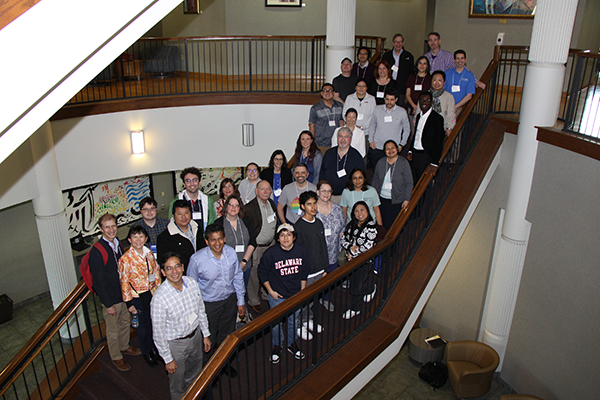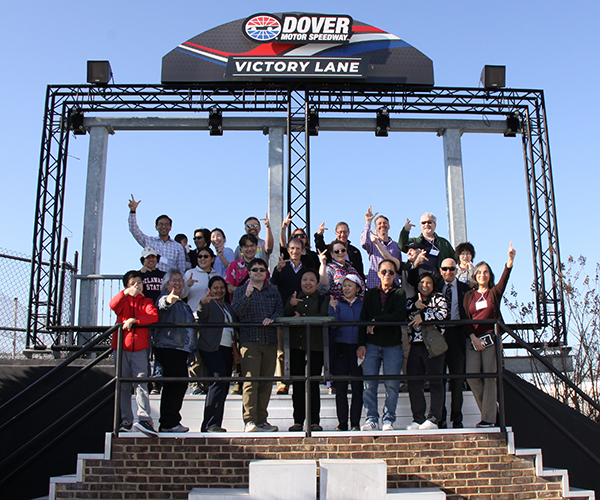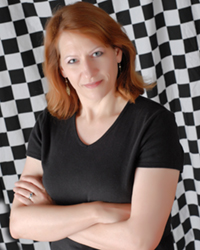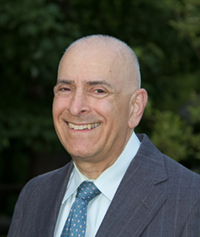- Indico style
- Indico style - inline minutes
- Indico style - numbered
- Indico style - numbered + minutes
- Indico Weeks View
CSAAPT Spring 2024 Semi-Virtual Meeting
→
US/Eastern
BOA 101 (Delaware State University, Bank of America Building)
BOA 101
Delaware State University, Bank of America Building
1200 N. DuPont Highway
Dover, DE 19901
Description


This Meeting is hosted and sponsored by the Physics and Engineering Unit in the Division of Physics, Engineering, Mathematics, and Computer Science at Delaware State University, with additional funding from DSU College of Agriculture, Science and Technology, the UVA Department of Physics, the VT Department of Physics, and the VT College of Science.
Overview:
The Spring 2024 Meeting of the Chesapeake Section of the American Association of Physics Teachers (CSAAPT) will be held on Saturday, March 16, 2024 at Delaware State University, one of the top HBCUs in Dover, the capital city of the State of Delaware.
No membership required!
You do not have to be an AAPT or CSAAPT member to attend. We welcome participation of all physics/astronomy/science teachers and students in the region (DC, DE, MD, VA and neighboring states) as well as anyone interested in physics education, or physics in general.
The semiannual CSAAPT meetings are a great forum to exchange ideas on novel teaching techniques and economical physics demonstrations, and to meet a fascinating cohort of physics education enthusiasts.
This meeting is semi-virtual. The in-person venue is the Bank of America Building at Delaware State University. Please see the Meeting Location page for details. The Meeting will be broadcast on Zoom so that people from afar (both presenters and attendees) can join in.
Lodging Support!
We have limited funds to provide up to $326 in lodging support to high school physics teachers. Please see the Travel and Lodging Info page for details.
Program:
- Continental breakfast will be available at the meeting site from 8:00AM. Lunch will also be provided.
- Please see Timetable for the detailed program. The pdf of the program can be created by clicking on the PDF button at the top of the Timetable page.
Featured Presentations:
- Dr. Diandra Leslie-Pelecky

Title: The Physics of NASCAR
Abstract: Most people watching a NASCAR race see racecars. Dr. Diandra Leslie-Pelecky sees a science experiment on wheels — and a way to interest more people in physics. She’s gotten behind-the-scenes access to race shops and personnel, driven the 24-degree banking of Texas Motor Speedway, and embedded with a race team. She shows fans how a team cannot win a NASCAR race without mastering math, science and engineering, and how their understand of the sport will be enhanced if they learn a little more about the science behind the speed.
In 75 years, NASCAR has evolved from moonshine and dirt tracks to computational fluid dynamics and finite element analysis. Dirt tracks are still part of the picture, but so are sweeping superspeedways and sprawling road courses. NASCAR has changed profoundly in the 16 years she’s been reporting on the sport. This will be the third year of racing with the seventh-generation Next Gen racecar, which looks more like a production car and has cutting edge safety features.
NASCAR has even built their first electric racecar.
Dr. Diandra will explain how racing isn’t as simple as mv2/r, how you can use cars to increase student interest. She’ll also explain how motorsports have the potential to help lead the change to more sustainable vehicles. Whether you’re a race fan curious to know why your driver is (or isn’t) winning, or a scientist wondering why people get so excited about cars driving in circles, you will enjoy learning about the science of speed.
Dr. Diandra Leslie-Pelecky is the author of The Physics of NASCAR and the Building Speed blog. She is a contributor to NBC Sports and SiriusXM Speedway. Outlets from the New York Times to Sporting News to Physics World have covered her work and drawn on her expertise.
Bio: A native of Milwaukee, Wisconsin, Diandra Leslie-Pelecky is a high-school dropout with a Ph.D. in physics. She earned undergraduate degrees in physics and philosophy at the University of North Texas and a Ph.D. in Condensed Matter Physics from Michigan State University. She built a career as a nationally respected nanomedical researcher and university professor at the University of Nebraska. Her work, funded by the National Science Foundation, the National Institutes of Health, the Department of Defense and the Department of Energy, focused on fundamental understanding of magnetic nanomaterials and their application to medicine.
Now a full-time writer, her book, The Physics of NASCAR, was excerpted by Time magazine and covered by outlets from the New York Times to the Materials Research Bulletin. She has been a Sigma Xi Distinguished Lecturer, as well as appeared on ESPN and NBC. Her science-of-motorsports blog, Building Speed is avidly read by NASCAR fans and insiders. She is a regular guest on the SiriusXM Speedway satellite radio program. Outside of motorsports, she writes speculative fiction and is a member of the DC Metrowriders group.
- Dr. Matthew Bobrowsky

Title: The Total Solar Eclipse on April 8, 2024
Abstract: This CSAAPT meeting is occurring less than a month before the total solar eclipse that will occur on April 8, 2024. In this presentation, we will describe the fascinating circumstances that will create April's spectacular event. Topics include:
- What is an eclipse?
- Why will the eclipse be so spectacular?
- From where can the eclipse be seen?
- How often do eclipses occur? When is the next one after April 8? (Spoiler alert: If you're in the U.S., you'll have to wait decades [!] to see another total solar eclipse.)
- How to safely view the eclipse. (Eclipse-viewing glasses will be available.)
- Fun facts and common misconceptions about the sun, moon, and eclipses.
There will also be a Q & A session. Come and hear about the eclipse -- and then plan to see it!
Bio: Dr. Matthew Bobrowsky is an astrophysicist, educator, and science communicator. Matt has received numerous teaching awards, including the University of Maryland Board of Regents' Faculty Award for Teaching Excellence. He has over 35 educational publications and over 35 scientific research publications, and he is the lead author of the “Phenomenon-Based Learning” series of books published by NSTA Press.
Matt has been at DSU for almost ten years. Besides teaching physics and astronomy, he also serves as director of the observatory, where he regularly conducts open houses at which students and the public can look through the telescope. In his scientific research, Matt has made astronomical observations with many telescopes, both on the ground and in space, including the Hubble Space Telescope. His specialty is the study of planetary nebulae — clouds of gas expanding outward from aging stars. He discovered several planetary nebulae using Hubble, including the Stingray Nebula. Matt lectures widely on astronomy, physics, eclipses, life in the universe, the process of science, Phenomenon-Based Learning, and science vs. pseudoscience.
Contributed Talks and Demos:
We solicit contributions within the following parameters:
- 15-minute talks (12 minute talk + 3-minute Q&A, Both in-person and via Zoom)
Talk topic/demo can be anything pertaining to physics teaching (No student research presentations please unless it is on physics education)
- Demo contribution to Demo Share-a-thon (in the afternoon, in-person only)
- To submit the title and abstract of your talk/demo, please register first and then click on Call for Abstracts in the menu
- The deadline to submit your title and abstract is midnight of Saturday, February 24, 2024
- Contributors of talks/demos will be issued a certificate of presentation
Registration:
- In-person attendance:
- Please use the in-person attendance registration form on the Registration page,
- The deadline to register for in-person attendance is midnight of Saturday, March 9, 2024. This is so that we have a count of how many people will be physically present one week prior to the Meeting.
- In-person attendees are requested the following registration fees to cover administrative and other costs:
- Instructors/faculty of 2-year and 4-year colleges/universities, employees of institutions/organizations/companies : $30
- K-12 Instructors, Retirees, Students, Guests : $20
- 1st-time in-person attendees : $10
- The registration fee is NOT payable upon registration. A link for you to directly pay the registration fee online will be emailed to you after the registration deadline.
- Please use the in-person attendance registration form on the Registration page,
- Remote Attendance:
- Please use the Zoom attendance registration form on the Registration page,
- The deadline to register for remote attendance is midnight of Friday, March 15, 2024.
- There is no registration fee for virtual (online) attendance.
- Please note that the Zoom link for the meeting will not be made public and will only be emailed to registrants. The Zoom link will be sent to you in a Zoom or calendar invite, so please pay attention to what you are receiving in your email.
- Once on Zoom, please change your Zoom name to your full name followed by your affiliation in parentheses, e.g. Jane Doe (Delaware State University). This is so that we can identify your presence for the purpose of issuing your certificates of attendance.
- Please use the Zoom attendance registration form on the Registration page,
- Certificate of Attendance/Presentation:
- Certificates of attendance/presentation will be issued to both in-person and virtual attendees/presenters.
- If you need a certificate of attendance and/or presentation, please register your name exactly as it should appear on your certificate(s). No nicknames or pseudonyms, please.
- A detailed program in pdf can be generated by clicking on the "PDF" button at the top of the "Timetable" page (once the timetable is available).
- Certificates of attendance/presentation will be issued to both in-person and virtual attendees/presenters.
Important Deadlines:
- Application for Lodging Support: midnight of Sunday, January 28, 2024
- Hotel room-block cutoff: midnight of Thursday, February 1, 2024
- Submission of talk and demo abstracts: midnight of Saturday, February 24, 2024
- Registration for in-person attendance: midnight of Saturday, March 9, 2024
- Registration for virtual attendance: midnight of Friday, March 15, 2024
Organizational Committee:
Qi Lu (Chair, Delaware State University, DE)
Mohammad Amir Khan (Delaware State University, DE)
Anupama Bhat (Delaware Technical Community College, DE)
Matthew Bobrowsky (Delaware State University, DE)
Tatsu Takeuchi (CSAAPT President, Virginia Tech, VA)
Muge Karagoz (CSAAPT Vice President, American Institute of Physics, MD)
Kausik Das (University of Maryland Eastern Shore, MD)
Rachele Dominguez (Randolph-Macon College, VA)
James Freericks (Georgetown University, DC)
Elena Kuchina (Virginia Peninsula Community College, VA)
Christy Metzger (University of Delaware, DE)
Carl Mungan (US Naval Academy, MD)
Jason Sterlace (James Madison University, VA)
Kent Yagi (University of Virginia, VA)
Participants
Ali Cherid
Amalia Americana Kondeti
Amir Khan
Andrei Blinkouski
Andres Akamine
Angel Selby
Angela Goad
Angham Abdulrazzaq
Anna Kosnic
Aristides Marcano
Brennan Barnhart
Carl Mungan
Chris Neu
Christina Walker
Colin Lewis
Curtis Jones
Daniela Topasna
Dedra Demaree
Diandra Leslie-Pelecky
DR DUSHYANT PRADEEP
Elana Resnick
George Murray
Gregory MacDougall
Gustavo Acosta
Hemalatha Bhaskaran
Henry Hilgendorf
Jack Gradle
James DeGrandis
James Freericks
Jared Cooper
Jason Sterlace
Jason Tran
Jency Sundararajan
Jessica Rosenberg
Judson Wagner
Kausik Das
Kent Yagi
Kris Lui
Laura Akesson
Leonardo Pierre
Lewis McIntyrr
Liliia Khmarskaia
Marco Brizzolara
Mark Akubo
Melanie Coronel
Mickey Maley
Mohammad Nouristani
Nicholas Hurtado
Nishchal Thapa Magar
Qi Lu
Robert Hilborn
Robert Morse
Ryan Bischof
Salem Mosleh
Sean Lally
Shane Brogan
Shunsaku Horiuchi
Soe Wunna
Stefano Colafranceschi
Tonyea Mead
Vance Nannini
Veronique Petit
- +48
